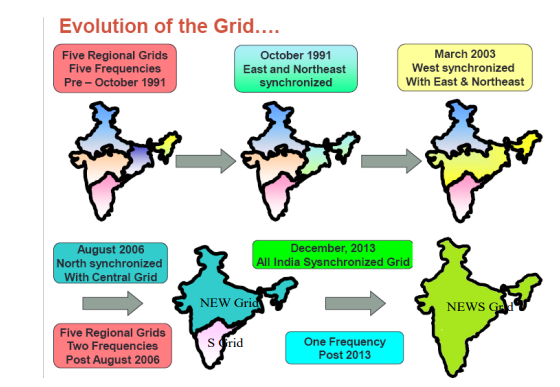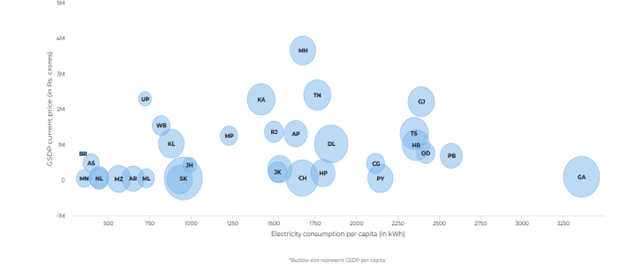THE CONTEXT: The ‘One Nation, One Grid, One Tariff’ policy is a transformative initiative to create a unified energy framework in India by standardizing electricity tariffs across states. This policy addresses regional economic and energy disparities. It aims to enhance industrial competitiveness in backward states, reduce poverty through affordable energy access, and foster inclusive growth.

CURRENT SCENARIO – A TALE OF TWO STATES:
| Parameters | BIHAR | DELHI |
| Population | Over 13 crores | Approximately 3.3 crore |
| Per capita income | ₹50,555 (below national average of ₹86,659) | ₹4,61,910 (2.5 times higher than national average) |
| Electricity consumption (FY 2023) | 30,338 GWh | 34,107 GWh |
| Per capita electricity consumption | 350 kWh annually | 1848 kWh annually |
| Recent tariff increase | 24.1% for FY 2023-2024 | Lower electricity tariffs |
THE ISSUES IN REGIONAL DEVELOPMENT AND ENERGY EQUITY:
-
- Economic Disparities: States with higher per capita income, like Maharashtra and Gujarat, attract more investments and have a more diversified economic base. Bihar, despite recent efforts, struggles to attract big-ticket investments, although there are signs of change with companies like Adani Group and Coca-Cola showing interest. Bihar’s economy remains largely agrarian, limiting its growth potential and job creation opportunities.
- Energy Inequities: For domestic consumers in Bihar, the tariff for consumption up to 100 units is ₹3.9 per kWh, with higher rates for increased consumption. In contrast, Delhi offers subsidized electricity, with domestic consumers paying ₹3 per unit for up to 200 units.
- Infrastructure Gaps: Bihar has introduced smart meters to improve billing accuracy and reduce power theft, which has led to increased bills and consumer dissatisfaction. The state is working on creating a land bank of 3,000 acres for setting up industries and offering 2.4 million sqft of ready-to-move Plug and Play Industrial Sheds.
- Poverty and Development: 59% of Bihar’s population faces multidimensional poverty. However, the state government has been providing subsidies to mitigate the impact, with a subsidy bill of around ₹8,000 crore last year. The 24% hike in power tariffs in Bihar will likely burden the poor further and impede industrial growth.
POTENTIAL BENEFITS OF ‘ONE NATION, ONE GRID, ONE TARIFF’:
-
- Economic Equity: Mitigating the current situation where industrial tariffs vary widely across states, with some states charging over ₹6/kWh. Creating a level playing field for industries across all states promotes balanced regional development.
- Poverty Alleviation: Affordable and reliable energy access would transform rural areas by powering schools, hospitals, and small businesses. By reducing energy costs, the policy could encourage the expansion of labor-intensive industries in backward states, creating new employment opportunities.
- Infrastructure Development: The unified grid has already improved regional power transfer and minimized frequency fluctuations. The current interregional transfer capacity stands at 112 gigawatts, with potential for further enhancement.
- Inclusive Growth: By standardizing energy prices, the policy could reduce the burden on households and businesses in states facing high tariffs. It can transform poverty alleviation efforts, especially in states with high multidimensional poverty rates.
CHALLENGES IN IMPLEMENTATION:
-
- Varied Infrastructure Readiness Across States: States like Gujarat and Karnataka have effectively integrated renewable energy into their power sectors and show adequate preparedness for further electricity transition. In contrast, states such as Jharkhand, Bihar, West Bengal, and Uttar Pradesh lag, necessitating comprehensive strategies to foster sustainable growth and transition in their power sectors.
- Regulatory Coordination Between Centre and States: Frequent policy changes have adversely impacted the growth of renewable energy deployment, necessitating policy stabilization for investor confidence. Implementing smart grid technology within the unified grid framework requires coordinated efforts between central and state agencies.
- Financial Implications of Tariff Unification: Distribution Companies (DISCOMs) accumulated liabilities have significantly impacted their ability to make timely payments to generating companies. By March 2023, Tamil Nadu DISCOM reported losses of over Rs. 1.6 lakh crores, while DISCOMs in Uttar Pradesh and Rajasthan reported losses of over Rs. 90,000 crores each. Tariff unification may lead to revenue losses for some states, necessitating a robust compensation mechanism.
WAY FORWARD FOR ‘ONE NATION, ONE GRID, ONE TARIFF’ POLICY:
-
- Centre-State Coordination: Establish a joint working group comprising representatives from the Ministry of Power, state energy departments, and regulatory bodies to ensure seamless policy alignment.
- Public-Private Partnerships (PPPs): Leverage PPPs for infrastructure development. For instance, the success of Tata Power-DDL in Delhi, which reduced AT&C losses from 53% to 7.3% over two decades, can be replicated in other states.
Phased Implementation Strategy:
Phase I—Infrastructure Alignment: Improve transmission and distribution infrastructure in lagging states. The National Smart Grid Mission, which aims to convert 70% of the country’s electrical grid into a smart grid by 2030, can be integrated into this phase.
Phase II – Regulatory Harmonization: Align state regulations with the central framework. The Forum of Regulators, established under the Electricity Act 2003, can play a pivotal role in this harmonization process.
Phase III—Tariff Unification: Gradually implement a unified tariff structure, starting with industrial and commercial consumers and then moving to domestic consumers. Maharashtra’s approach of announcing a five-year tariff trajectory with provisions for mid-term revisions can be considered a model.
Phase IV—Full Integration: This phase involves the complete integration of all states into the ‘One Nation, One Grid, One Tariff’ system. Its goal is to achieve the vision of a single national electricity market.
-
- Digital Literacy: Promote digital literacy to help consumers understand and utilize smart metering systems. The National Digital Literacy Mission can be leveraged to include energy management in its curriculum.
- Grievance Redressal Mechanism: Establish a robust, easily accessible grievance redressal system. The success of the SAUBHAGYA scheme’s grievance redressal mechanism, which resolved over 10 lakh complaints by 2019, can be emulated.
THE CONCLUSION:
Successfully implementing the ‘One Nation, One Grid, One Tariff’ policy requires a multifaceted approach combining collaborative governance, phased implementation, and consumer-centric strategies. By learning from successful models within India and adapting global best practices, this policy can transform India’s power sector, fostering economic equity and sustainable development across all states.
UPSC PAST YEAR QUESTIONS:
Q.1 How far do you think cooperation, competition, and confrontation have shaped the nature of federation in India? Cite some recent examples to validate your answer. 2020
Q.2 Investment in infrastructure is essential for more rapid and inclusive economic growth. Discuss in the light of India’s experience. 2021
MAINS PRACTICE QUESTION:
Q.1 “The ‘One Nation, One Grid, One Tariff’ policy has the potential to transform India’s power sector and address regional economic disparities.” Critically examine
SOURCE:
https://www.deccanherald.com/opinion/economic-federalism-india-needs-a-unified-power-grid-3319150
Spread the Word

